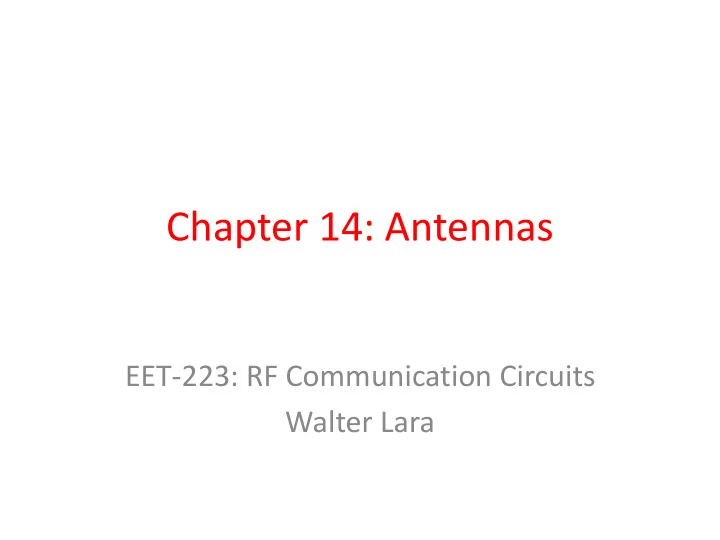

Chapter 14: Antennas EET-223: RF Communication Circuits Walter Lara
Basic Antenna Theory • In a transmitter system, an antenna provides a transition from a guided wave on a transmission line to an electromagnetic wave – RF currents flowing through the antenna produce electromagnetic waves that radiate into the atmosphere • In a receiver system, an antenna provides a mean for the collection of electromagnetic waves – E lectromagnetic waves “cutting” through the antenna induce RF currents for use by the receiver
Basic Antenna Theory – Cont’d • The reciprocity principle states that any antenna can transmit or receive with the same efficiency – Occurs because antenna characteristics are the same regardless of whether the antenna is transmitting or receiving – Because of that, typically we only study transmission • Polarization is the direction of the electric field of a given electromagnetic radiated signal – Vertical antenna transmits vertically polarized wave and received signal is theoretically zero if vertical electric field cuts through horizontal receiving antenna – Same idea applies for horizontal or any other angle
Half-Wave Dipole Antenna: Introduction • Two open-ended wires physically oriented 180° apart hooked to opposite voltage terminals • Physical length equals half-wavelength ( λ /2) of applied frequency • Predominantly used with frequencies above 2 MHz – Lower frequencies require impractical antenna sizes – What antenna size would be require for 60-Hz? 2-MHz?
Half-Wave Dipole Antenna: How does it work? • As discussed in Chapter 12, the characteristics of an open-ended, quarter-wave transmission line segment (Fig 14-1) are such that: – Voltage is close to zero at input and maximum at end – Current is maximum at input and close to zero at end • But two-wire line cannot maximize radiation because magnetic field surrounding each conductor is in a direction that opposes the lines of forces about the other conductor – Solution: bending each line outward 90° to form λ /2 antenna (see Fig 14-2)
Figure 14-1 Quarter-wave transmission line segment (open-ended).
Figure 14-2 Basic half-wave dipole antenna.
Half-Wave Dipole Antenna: How does it work? – Cont’d • Another problem of the open-ended line is that it cannot absorb and radiate power because source sees close to zero impedance – Solution: gap between input terminals of λ /2 antenna forces input impedance to be close to 73 Ω , instead of close to 0 Ω (see Fig 14-3)
Figure 14-3 Impedance along a half-wave antenna.
Half-Wave Dipole Antenna: Radiation and Induction Field • Radiation Field (Far Field): radiation that surrounds an antenna but does not collapse its field back into the antenna but rather radiate it out into the atmosphere • Induction Field (Near Field): radiation that surrounds an antenna and collapses its field back into the antenna • The effects of the Near Field become negligible at a distance more than about one-half wavelength from the antenna
Half-Wave Dipole Antenna: Radiation and Induction Field – Cont’d • The Far-Field region begins when the distance: R ff = 1.6 λ if D/ λ < 0.32 R ff = 5D if 0.32 < D/ λ < 2.5 R ff = 2D 2 / λ if D/ λ ≥ 2.5 Where: R ff = far field distance from antenna (m) D = dimension of the antenna (m) λ = wavelength of transmitted signal (m/cycle)
Half-Wave Dipole Antenna: Radiation Pattern • A radiation pattern is a diagram indicating the radiated field strength around an antenna as a function of direction • Because of the reciprocity principle, the radiation pattern is the same for receiving or transmitting • The beamwidth is the angular separation between half- power points of an antenna’s radiation pattern • The radiation pattern of a half-dipole antenna is doughnut-shaped (see Fig 14-5)
Half-Wave Dipole Antenna: Radiation Pattern – Cont’d • The maximum field strength for the half-dipole antenna occurs at right angles to the antenna and it is close to zero “off the ends” (see Fig 14 -4a) • The radiation pattern of an isotropic source is a sphere or, if shown in two dimensions, it is circular or omnidirectional (see Fig 14-4b)
Figure 14-5 Three-dimensional radiation pattern for a /2 dipole.
Figure 14-4 Radiation patterns.
Half-Wave Dipole Antenna: Antenna Gain • The antenna gain is a measure of how much more power an antenna radiates in a certain direction with respect to that which would be radiated by an isotropic source (measured in dBi) – Half-wave dipole antenna at right angles: 1.15 dB • When the gain of an antenna is multiplied by its power input, the result is termed as effective radiated power (ERP) – Can be in Watts, dBW or dBm – Characterizes both antenna pattern and transmitted power in one quantity
Half-Wave Dipole Antenna: Antenna Gain – Cont’d • The amount of power received by an antenna (P r ) can be computed as: P r = P t G t G r λ 2 16π 2 d 2 Where: P t = power transmitted (W) G t = transmitting antenna to isotropic gain ratio G r = receiving antenna to isotropic gain ratio λ = wavelength (m) d = distance between antennas (m) • For half-wave dipole antenna at optimum reception alignment: G t = G r = 1.64
Recommend
More recommend